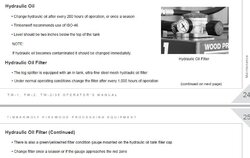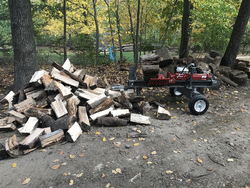Now, the TW: That is ironic. About two days before you posted I ran one a few hours at a charity firewood cut in WI. There were one processor and four splitters, so some details are fuzzy, but I remember that one. TW is a great brand and I was curious to see how their entry level machine ran.
This one had a vertical shaft Subaru engine, guessing 5-6 hp. Probably 11/2.7 gpm two stage pump. Fixed wedge. 4 inch? cylinder. Rectangular tube tank/axle about 4x8 or 10 high.
We used it about 2 or 3 hours. I don't want to sound arrogant, or telling someone they have an ugly baby, but my first impressions were that, for a major brand with good reputation, this entry level model does about everything wrong.
That said, ANY hydraulic splitter is way better than a maul, and most of the things I didn't like can be modified or fixed. Here are my impressions:
-Way too low working height for my back. We put it up on logs, so problem solved, but it did slip off once and could be wobbly. I don't recall, but think it would be fairly easy to cut the stub axles off, add another 12 inches of large tubing and mount the axles much lower. Extending the front stand would be easy.
-Log cradles were too far towards cylinder, in the operators way, and not very useful for short stuff.
-No outfeed tables. Needed two operators, one on valve, and one with two hands on splits or they fall on the ground. For one operator, or larger rounds even with two operators, definitely needs tables on sides of the wedge. Make something out of plywood or rounds or whatever.
-Odd stepped wedge. Lower part is first to engage, so force is concentrated closed to beam, for minimal bending on wedge, which is good, but a few rounds tended to skate upwards. Given that a wedge to beam connection is long and strong, I would rather have the top of wedge bite first, and force the round down.
-Wedge maybe 8 inches high. OK, was doing fairly small diameter rounds, but I would prefer 12 high. We didn't do anything larger than about 14 inch diameter.
-Moving push plate very low, maybe 6 inches high. Definite problem on second pass (quartering pass) as the push plate often went under the half round on top and only the bottom one got quartered. That added an additional stroke and needed three cycles instead of two.
-Push plate stopped 2 or 3 inches short of wedge. This was an aggravation but ok doing oak. We had to tear the last fibers quite often but usually oak splits through ok. It would be totally unacceptable on stringy elm or cottonwood as every round would be incomplete split. Either fight to pull the wood apart, with risk of hands hitting metal, or retract, put the next round in behind it, and push the first one through. Then, asap, let go of the new round on the beam, and catch the pieces of the previous round off the wedge as they split the last couple inches, before they drop to the ground. Cylinder has plenty of stroke. I would definitely make a drop-over, or weld on, extension with vertical bars on the push plate so the sides of the push plate went past the point of wedge by an inch or so.
-Not very fast but this is common on most consumer splitters.
-Valve did not have detent on return. Since it required two people to run (one needs both hands on the splits) this did not matter. For one person operation, it would matter.
-Return filter is in tank mounted to top. Nice. (I don't recall brand.) Had differential pressure gauge to indicate dirty filter. Nice. Needs guard over the gauge/filter. An errant round could break it off and machine would be down. Per Hearth post, it is a stainless steel mesh filter and never seems to fill up. SS mesh would probably be 50-75 micron at best, so I would cross reference to a 10 to 25 micron synthetic (glass) pleated element.
-Pump on vertical shaft engine was down fairly low.
-I don't recall what the breather was, or whether it was covered from dirt and junk. Ran several machines that day.
We figured out work arounds and got a lot done though, regardless of my negative comments. Again, it is FAR better than a maul or wedge. I am old and would rather be slow than sore.







